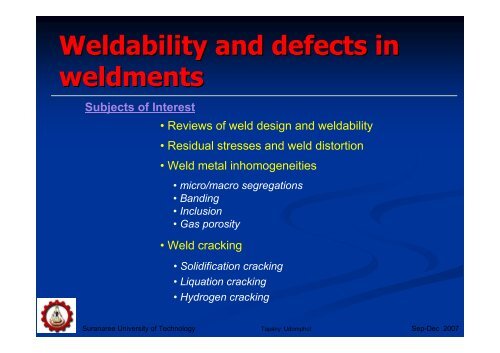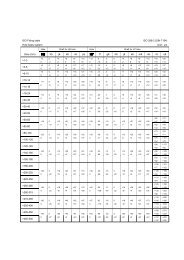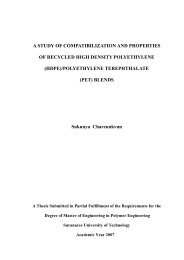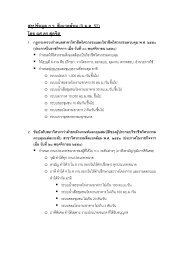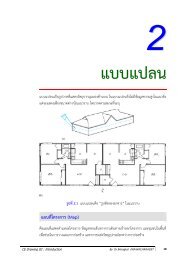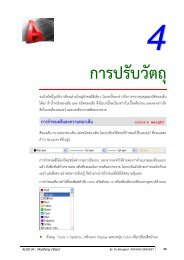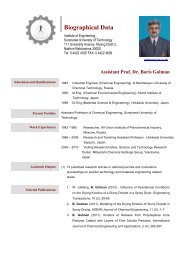06_ Weldability and defects in weldments.pdf
06_ Weldability and defects in weldments.pdf
06_ Weldability and defects in weldments.pdf
You also want an ePaper? Increase the reach of your titles
YUMPU automatically turns print PDFs into web optimized ePapers that Google loves.
<strong>Weldability</strong> <strong>and</strong> <strong>defects</strong> <strong>in</strong><br />
<strong>weldments</strong><br />
Subjects of Interest<br />
• Reviews of weld design <strong>and</strong> weldability<br />
• Residual stresses <strong>and</strong> weld distortion<br />
• Weld metal <strong>in</strong>homogeneities<br />
• micro/macro segregations<br />
• B<strong>and</strong><strong>in</strong>g<br />
• Inclusion<br />
• Gas porosity<br />
• Weld crack<strong>in</strong>g<br />
• Solidification crack<strong>in</strong>g<br />
• Liquation crack<strong>in</strong>g<br />
• Hydrogen crack<strong>in</strong>g<br />
Suranaree University of Technology Tapany Udomphol<br />
Sep-Dec 2007
Objectives<br />
This chapter aims to:<br />
• Students are required to underst<strong>and</strong> the causes of<br />
residual stresses, distortion <strong>and</strong> their remedies.<br />
• Students are also required to differentiate weld <strong>defects</strong><br />
that might occur dur<strong>in</strong>g metal weld<strong>in</strong>g for example,<br />
solidification crack<strong>in</strong>g, liquation crack<strong>in</strong>g, distortion, weld<br />
embrittlement.<br />
• Students can suggest possible remedies associated<br />
with <strong>in</strong>dividual weld <strong>defects</strong>.<br />
Suranaree University of Technology Tapany Udomphol<br />
Sep-Dec 2007
Weld design – jo<strong>in</strong>t type<br />
Five basic jo<strong>in</strong>t types<br />
Welds are made at the junction of all the pieces<br />
that make up the weldment (assembled part).<br />
A: Butt jo<strong>in</strong>t<br />
B: Corner jo<strong>in</strong>t<br />
C: T-jo<strong>in</strong>t<br />
D: Lap jo<strong>in</strong>t<br />
• A jo<strong>in</strong>t between two members aligned<br />
approximately <strong>in</strong> the same plane.<br />
• A jo<strong>in</strong>t between two members located<br />
approximately at right angles to each other<br />
<strong>in</strong> the form of an L.<br />
• A jo<strong>in</strong>t between two members located<br />
approximately at right angles to each other<br />
<strong>in</strong> a form of a T.<br />
• A jo<strong>in</strong>t between two overlapp<strong>in</strong>g<br />
members located <strong>in</strong> parallel.<br />
D: Edge jo<strong>in</strong>t •A jo<strong>in</strong>t between the edges of two or more<br />
parallel or nearly parallel members.<br />
Suranaree University of Technology Tapany Udomphol<br />
Sep-Dec 2007
Weld design – weld type<br />
• There are eight weld types:<br />
Fillet weld - On the jo<strong>in</strong>t<br />
Groove weld<br />
Back weld<br />
Slot weld<br />
Spot weld<br />
Seam weld<br />
- In the jo<strong>in</strong>t<br />
- Made on the backside of the<br />
jo<strong>in</strong>t<br />
- Used with prepared holes<br />
- Weld at the <strong>in</strong>terface of the<br />
members<br />
- Without prepared holes<br />
Stud weld - Weld<strong>in</strong>g a metal stud<br />
Surface weld<br />
- Weld beads deposited on the<br />
base metal or broken surface<br />
Suranaree University of Technology Tapany Udomphol<br />
Sep-Dec 2007
Weld design – Fillet weld<br />
Fillet weld<br />
Def<strong>in</strong>itions of different parts <strong>in</strong> fillet weld<br />
Suranaree University of Technology Tapany Udomphol<br />
Sep-Dec 2007
Weld design – Groove weld<br />
• There are seven basic groove welds:<br />
square, V, bevel, U, J, flare V <strong>and</strong> flare<br />
bevel.<br />
Groove weld<br />
Types of groove welds<br />
Suranaree University of Technology Tapany Udomphol<br />
Sep-Dec 2007
Weld approval<br />
For quality control Weld<strong>in</strong>g<br />
procedure sheet is approved <strong>and</strong><br />
distributed to personnel concerned with<br />
its implementation.<br />
Details<br />
• approval of weld<strong>in</strong>g process<br />
• weld design<br />
• Electrode used<br />
• consumable used: filler, shield<strong>in</strong>g gas, flux<br />
• Inspection technique used<br />
Suranaree University of Technology Tapany Udomphol<br />
Sep-Dec 2007
<strong>Weldability</strong><br />
Def<strong>in</strong>ition<br />
The capability of a material to be welded under the imposed<br />
fabrication conditions <strong>in</strong>to a specific, suitably designed structure<br />
<strong>and</strong> to perform satisfactorily <strong>in</strong> the <strong>in</strong>tended service.<br />
www.twi.co.uk<br />
• <strong>Weldability</strong> depends on various factors such as, nature<br />
of metals, weld designs, weld<strong>in</strong>g techniques, skills, etc.<br />
• It has been stated that all metals are weldable but<br />
some are more difficult than another.<br />
• Steel is readily weldable (<strong>in</strong> many ways) than<br />
alum<strong>in</strong>ium <strong>and</strong> copper.<br />
• Copper is not easily welded due to its high thermal<br />
conductivity which makes it difficult to raise the parent<br />
metal to its melt<strong>in</strong>g po<strong>in</strong>t. require preheat<strong>in</strong>g ~300-<br />
400 o C.<br />
• Some alum<strong>in</strong>ium based die cast<strong>in</strong>g alloys give weld<br />
pool too large to control, <strong>and</strong> alum<strong>in</strong>ium welds normally<br />
have oxide <strong>in</strong>clusions <strong>and</strong> porosity.<br />
Suranaree University of Technology Tapany Udomphol<br />
Sep-Dec 2007
<strong>Weldability</strong><br />
Steels<br />
• <strong>Weldability</strong> of steels is <strong>in</strong>versely proportional to its hardenability,<br />
due to martensite formation dur<strong>in</strong>g heat treatment<br />
Carbon content<br />
Hardenability<br />
<strong>Weldability</strong><br />
• There is a trade-off between materials strength <strong>and</strong> weldability.<br />
• Austenitic sta<strong>in</strong>less steels tend to be the most weldable but suffer<br />
from distortion due to high thermal expansion. Crack<strong>in</strong>g <strong>and</strong> reduced<br />
corrosion resistance.<br />
• Ferritic <strong>and</strong> martensitic sta<strong>in</strong>less steels are not easily welded, often<br />
to be preheated <strong>and</strong> use special electrodes.<br />
• Ferritic steels is susceptible to hot crack<strong>in</strong>g if the ferrite amount is not<br />
controlled.<br />
Suranaree University of Technology Tapany Udomphol<br />
Sep-Dec 2007
<strong>Weldability</strong><br />
Alum<strong>in</strong>ium <strong>and</strong> its alloys<br />
• <strong>Weldability</strong> of alum<strong>in</strong>ium depends on<br />
chemical composition of the alloy.<br />
• Alum<strong>in</strong>ium alloys are susceptible to hot crack<strong>in</strong>g, oxide <strong>in</strong>clusions,<br />
dross, porosity (hydrogen).<br />
• Most of wrought series, 1xxx, 3xxx, 5xxx, 6xxx, <strong>and</strong> medium strength<br />
7xxx can be fusion welded by TIG, MIG while 2xxx <strong>and</strong> high strength<br />
7xxx are not readily welded due to liquation <strong>and</strong> solidification crack<strong>in</strong>g.<br />
Cracks<br />
www.mig-weld<strong>in</strong>g.co.uk<br />
Cracks <strong>in</strong> alum<strong>in</strong>ium welds<br />
Porosity<br />
Porosity observed <strong>in</strong> alum<strong>in</strong>ium welded specimen<br />
after fractured.<br />
Suranaree University of Technology Tapany Udomphol<br />
Sep-Dec 2007
<strong>Weldability</strong><br />
Copper <strong>and</strong> copper alloys<br />
Copper<br />
Brasses<br />
Bronzes<br />
• <strong>Weldability</strong> of copper depends on<br />
chemical composition of the alloy.<br />
• High thermal conductivity required preheat<strong>in</strong>g to<br />
counteract heat s<strong>in</strong>k effect.<br />
• Can be TIG or MIG welded.<br />
• Volatilization (toxic) of z<strong>in</strong>c is the ma<strong>in</strong> problem, reduc<strong>in</strong>g<br />
weldability.<br />
• Low z<strong>in</strong>c content brass can be TIG or MIG welded.<br />
• Most are weldable, except gun metal or phosphor bronzes.<br />
• Require careful clean<strong>in</strong>g <strong>and</strong> deoxidization to avoid porosity.<br />
• Silicon improves weldability due to its deoxidiz<strong>in</strong>g <strong>and</strong> flux<strong>in</strong>g actions.<br />
• Oxygen causes porosity <strong>and</strong> reduce strength of welds.<br />
• T<strong>in</strong> <strong>in</strong>creases hot-cracked susceptibility dur<strong>in</strong>g weld<strong>in</strong>g.<br />
• Precipitation hardened alloys should be welded <strong>in</strong> the annealed<br />
condition, <strong>and</strong> then precipitation harden<strong>in</strong>g treatment.<br />
Suranaree University of Technology Tapany Udomphol<br />
Sep-Dec 2007
<strong>Weldability</strong><br />
Titanium alloys<br />
• <strong>Weldability</strong> of titanium depends on<br />
chemical composition of the alloy.<br />
• Titanium alloys with low amounts of alloy<strong>in</strong>g elements are more readily welded.<br />
For example: CP titanium alloys, α, α, α, α, α+β α+β α+β α+β titanium alloys.<br />
• Highly stabilised beta titanium alloys are difficult to weld due to segregation.<br />
• Weld<strong>in</strong>g at above 500-550 o C requires special precaution.<br />
• Fluxes are not normally used s<strong>in</strong>ce they comb<strong>in</strong>e with titanium to cause<br />
brittleness.<br />
• Weld<strong>in</strong>g processes: TIG, MIG, PAW, LBW, EBW, FW, RW.<br />
• Shield<strong>in</strong>g gases: Ar, He or the mixture of the two (avoid contact with oxygen).<br />
• Filler metal grades should match the alloys be<strong>in</strong>g welded, normally with lower<br />
yield strength to reta<strong>in</strong> ductility. (used unalloyed with lower ββββ content to avoid<br />
martensite transformation <strong>and</strong> with m<strong>in</strong>imised O, N, H contents).<br />
• Thoriated tungsten electrodes (EWTh-1 or EWTh-2) are used for TIG weld<strong>in</strong>g.<br />
Suranaree University of Technology Tapany Udomphol<br />
Sep-Dec 2007
<strong>Weldability</strong><br />
Magnesium alloys<br />
• <strong>Weldability</strong> of titanium depends on<br />
chemical composition of the alloy.<br />
• Weld<strong>in</strong>g processes: Arc weld<strong>in</strong>g, RW as well as oxyacetylene weld<strong>in</strong>g,<br />
braz<strong>in</strong>g. TIG <strong>and</strong> MIG are recommended.<br />
• Strength of the weld jo<strong>in</strong>t is lowered <strong>in</strong> the base metal, <strong>in</strong> the work<br />
hardened condition, due to recrystallisation <strong>and</strong> gra<strong>in</strong> growth <strong>in</strong> the HAZ.<br />
• Similar to weld<strong>in</strong>g of alum<strong>in</strong>ium, magnesium has low melt<strong>in</strong>g po<strong>in</strong>t, high<br />
thermal conductivity, thermal expansion, oxide surface coat<strong>in</strong>g.<br />
• In Mg-Al-Zn alloys (AZxx), Al >10% improves weldability by ref<strong>in</strong><strong>in</strong>g gra<strong>in</strong><br />
structure, while Zn > 1% <strong>in</strong>creases hot shortness.<br />
• Filler metals are selected by the composition of the base metals.<br />
Suranaree University of Technology Tapany Udomphol<br />
Sep-Dec 2007
Defects <strong>in</strong> <strong>weldments</strong><br />
• It is unusual for the <strong>weldments</strong> to be completely sound.<br />
• They normally conta<strong>in</strong> small <strong>defects</strong> such as porosity, slag, oxide<br />
<strong>in</strong>clusions, lack of fusion, undercut, crack, distortion, etc.<br />
Cross sections of welds conta<strong>in</strong><strong>in</strong>g typical <strong>defects</strong><br />
Underst<strong>and</strong><br />
the cause<br />
Solve/prevent<br />
the problem<br />
• Furthermore, different<br />
metals have different<br />
weldability so we need to<br />
underst<strong>and</strong> the nature of the<br />
metal to be welded.<br />
Suranaree University of Technology Tapany Udomphol<br />
Sep-Dec 2007
Defects <strong>in</strong> <strong>weldments</strong><br />
Incomplete fusion<br />
Groove welds <strong>and</strong><br />
various <strong>defects</strong><br />
Root <strong>and</strong> jo<strong>in</strong>t penetrations<br />
Suranaree University of Technology Tapany Udomphol<br />
Sep-Dec 2007
Residual stresses <strong>in</strong> weldment<br />
Residual stresses (<strong>in</strong>ternal stresses) are<br />
stresses that would exist <strong>in</strong> a body after<br />
remov<strong>in</strong>g all external loads (normally due<br />
to non uniform temperature change dur<strong>in</strong>g<br />
weld<strong>in</strong>g <strong>in</strong> this case).<br />
• Weld metal <strong>and</strong> adjacent base<br />
metal are restra<strong>in</strong>ed by the areas<br />
further away from the weld metal due<br />
to expansion <strong>and</strong> contraction.<br />
Weld metal <strong>and</strong><br />
adjacent base metal<br />
Areas further away<br />
from weld metal<br />
Residual tensile<br />
stresses<br />
Residual<br />
compressive<br />
stresses<br />
Thermally <strong>in</strong>duced residual stresses <strong>in</strong> weld.<br />
Suranaree University of Technology Tapany Udomphol<br />
Sep-Dec 2007
Changes <strong>in</strong> temperature <strong>and</strong> stresses<br />
dur<strong>in</strong>g weld<strong>in</strong>g<br />
• Zero temperature <strong>and</strong> stress<br />
distribution at A-A.<br />
• Small compressive <strong>in</strong> the<br />
weld zone <strong>and</strong> small tensile <strong>in</strong><br />
the base metal at B-B dur<strong>in</strong>g<br />
melt<strong>in</strong>g of the weld metal.<br />
• Develop<strong>in</strong>g of tensile stress<br />
<strong>in</strong> the weld centre <strong>and</strong><br />
compressive <strong>in</strong> the area further<br />
away at C-C dur<strong>in</strong>g cool<strong>in</strong>g.<br />
• Further contraction of the<br />
weld metal produc<strong>in</strong>g higher<br />
tensile stress <strong>in</strong> the weld centre<br />
<strong>and</strong> compressive <strong>in</strong> the base<br />
metal at D-D.<br />
Changes <strong>in</strong> temperature <strong>and</strong> stresses dur<strong>in</strong>g weld<strong>in</strong>g<br />
Suranaree University of Technology Tapany Udomphol<br />
Sep-Dec 2007
Typical residual stress distribution <strong>in</strong><br />
weldment (longitud<strong>in</strong>al)<br />
• Residual stress distribution across the weld shows tensile <strong>in</strong> the weld<br />
metal <strong>and</strong> the adjacent base metal <strong>and</strong> then goes compressive <strong>in</strong> the area<br />
further away from the weld metal.<br />
• Residual tensile stresses are not<br />
desirable, which can cause problems<br />
such as hydrogen <strong>in</strong>duced crack<strong>in</strong>g<br />
<strong>and</strong> stress corrosion crack<strong>in</strong>g.<br />
Remedies<br />
• Post weld heat treatment is often<br />
used to reduce residual stresses.<br />
• Other techniques : preheat<strong>in</strong>g,<br />
peen<strong>in</strong>g, vibration have also been<br />
used for stress relief.<br />
Tension<br />
zone<br />
Typical residual stress (longitud<strong>in</strong>al)<br />
distribution <strong>in</strong> weldment<br />
Suranaree University of Technology Tapany Udomphol<br />
Sep-Dec 2007
Effect of temperature <strong>and</strong> time on<br />
stress relief of steel welds<br />
Stress relief temperature % Relief of <strong>in</strong>itial stress<br />
Suranaree University of Technology Tapany Udomphol<br />
Sep-Dec 2007
Typical thermal treatments for stress<br />
reliev<strong>in</strong>g <strong>weldments</strong><br />
Suranaree University of Technology Tapany Udomphol<br />
Sep-Dec 2007
Distortion<br />
• Weld distortion is due to solidification shr<strong>in</strong>kage <strong>and</strong> thermal contraction<br />
of the weld metal dur<strong>in</strong>g weld<strong>in</strong>g.<br />
Distortion <strong>in</strong> welded structure<br />
Suranaree University of Technology Tapany Udomphol<br />
Sep-Dec 2007
Angular distortion<br />
S<strong>in</strong>gle-pass-s<strong>in</strong>gle-V groove butt jo<strong>in</strong>t<br />
Multiple-pass-s<strong>in</strong>gle-V groove butt jo<strong>in</strong>t<br />
• Upward angular distortion<br />
usually occurs when the weld is<br />
made from the top of the workpiece<br />
alone.<br />
• The weld tends to be wider at the<br />
top than the bottom, caus<strong>in</strong>g more<br />
solidification shr<strong>in</strong>kage <strong>and</strong><br />
thermal contraction.<br />
Th<strong>in</strong> plates<br />
Thick plates<br />
Inside fillet<br />
corner jo<strong>in</strong>t<br />
Fabricated beam<br />
Distortion <strong>in</strong> fillet weld<strong>in</strong>g of T jo<strong>in</strong>t<br />
Suranaree University of Technology Tapany Udomphol<br />
Sep-Dec 2007
Remedies for angular distortion<br />
There are several techniques used to reduce<br />
angular distortion.<br />
• Reduc<strong>in</strong>g volume of weld metal<br />
• Us<strong>in</strong>g double-V jo<strong>in</strong>t <strong>and</strong> alternate weld<strong>in</strong>g<br />
• Plac<strong>in</strong>g welds around neutral axis<br />
• Controll<strong>in</strong>g weld distortion<br />
Plac<strong>in</strong>g weld around neutral axis<br />
Reduc<strong>in</strong>g volume of weld metal <strong>and</strong><br />
by us<strong>in</strong>g s<strong>in</strong>gle-pass deep<br />
penetration weld<strong>in</strong>g.<br />
Suranaree University of Technology Tapany Udomphol<br />
Sep-Dec 2007
Remedies for angular distortion<br />
• Balanc<strong>in</strong>g the angular weld distortion<br />
on either side of the double V jo<strong>in</strong>t.<br />
Us<strong>in</strong>g double-V jo<strong>in</strong>t <strong>and</strong> weld<br />
alternately on either side of jo<strong>in</strong>t.<br />
(a) Symmetrical<br />
double V (b) Asymmetrical<br />
double V<br />
(c) S<strong>in</strong>gle U<br />
• Double V-jo<strong>in</strong>ts balance the shr<strong>in</strong>kage almost<br />
same amount of contraction on each side (a).<br />
• Asymetrical double V : The first weld always<br />
produces more angular distortion the second side<br />
is larger too pull back the distortion when the first<br />
weld is made (b).<br />
• A s<strong>in</strong>gle U jo<strong>in</strong>t gives a uniform weld with through<br />
the section (c).<br />
Suranaree University of Technology Tapany Udomphol<br />
Sep-Dec 2007
Remedies for angular distortion<br />
Methods for controll<strong>in</strong>g weld distortion:<br />
• Presett<strong>in</strong>g: by compensat<strong>in</strong>g the amount of distortion to occur <strong>in</strong> weld<strong>in</strong>g.<br />
• Elastic prespr<strong>in</strong>g<strong>in</strong>g can reduce angular changes after restra<strong>in</strong>t is removed.<br />
• Preheat<strong>in</strong>g <strong>and</strong> post weld treatment<br />
(a) Preset<strong>in</strong>g<br />
(b) Spr<strong>in</strong>g<strong>in</strong>g (c) Perheat<strong>in</strong>g<br />
Suranaree University of Technology Tapany Udomphol<br />
Sep-Dec 2007
Longitud<strong>in</strong>al distortion<br />
• Heat<strong>in</strong>g <strong>and</strong> cool<strong>in</strong>g cycles along the jo<strong>in</strong>t dur<strong>in</strong>g weld<strong>in</strong>g build up a<br />
cumulative effect of longitud<strong>in</strong>al bow<strong>in</strong>g.<br />
Longitud<strong>in</strong>al bow<strong>in</strong>g of<br />
distortion <strong>in</strong> a butt jo<strong>in</strong>t<br />
Remedies<br />
• Weld<strong>in</strong>g short lengths on a planned or r<strong>and</strong>om<br />
distribution are used to controlled this problem.<br />
• Mechanical methods : straighten<strong>in</strong>g press,<br />
jacks, clamps<br />
• Thermal methods : local heat<strong>in</strong>g to relieve<br />
stresses (us<strong>in</strong>g torches) but cannot be used for<br />
highly conductive metal such as Al <strong>and</strong> Cu.<br />
Sequences for<br />
weld<strong>in</strong>g short<br />
lengths of a jo<strong>in</strong>t to<br />
reduce longitud<strong>in</strong>al<br />
bow<strong>in</strong>g<br />
Suranaree University of Technology Tapany Udomphol<br />
Sep-Dec 2007
Longitud<strong>in</strong>al distortion<br />
• Angular distortion <strong>and</strong> longitud<strong>in</strong>al bow<strong>in</strong>g can also be observed <strong>in</strong><br />
jo<strong>in</strong>ts made with fillet welds such as fillet-welded T jo<strong>in</strong>t.<br />
Longitud<strong>in</strong>al bow<strong>in</strong>g <strong>in</strong> a filletwelded<br />
T jo<strong>in</strong>t<br />
Remedies<br />
• Back-step technique is also used. Each<br />
small <strong>in</strong>crement will have its own shr<strong>in</strong>kage<br />
pattern which then becomes <strong>in</strong>significant to<br />
the whole pattern of weldment. (But time<br />
consum<strong>in</strong>g)<br />
• Us<strong>in</strong>g the smallest possible weld size.<br />
Back step technique<br />
Suranaree University of Technology Tapany Udomphol<br />
Sep-Dec 2007
Weld metal chemical<br />
<strong>in</strong>homogeneities<br />
• Micro segregation<br />
• Macro segregation<br />
• B<strong>and</strong><strong>in</strong>g<br />
• Inclusions <strong>and</strong> gas porosity.<br />
Suranaree University of Technology Tapany Udomphol<br />
Sep-Dec 2007
Micro segregation<br />
• Lack of solid state diffusion might cause micro segregation <strong>in</strong> <strong>weldments</strong>.<br />
EX: Solid state diffusion <strong>in</strong> a more<br />
closely packed FCC structure<br />
(austenite) is more difficult than a<br />
more open BCC structure (ferrite).<br />
Microsegregation across columnar<br />
dendrite near quenched weld pool <strong>in</strong><br />
a martensitic sta<strong>in</strong>less steel.<br />
Suranaree University of Technology Tapany Udomphol<br />
Sep-Dec 2007
B<strong>and</strong><strong>in</strong>g<br />
• B<strong>and</strong><strong>in</strong>g occurs due to fluctuations <strong>in</strong> weld<strong>in</strong>g speed <strong>and</strong> power <strong>in</strong>put.<br />
B<strong>and</strong><strong>in</strong>g <strong>and</strong> rippl<strong>in</strong>g near centrel<strong>in</strong>e of as-welded top surface<br />
of a 304 sta<strong>in</strong>less steel YAG laser welded.<br />
Suranaree University of Technology Tapany Udomphol<br />
Sep-Dec 2007
Inclusions <strong>and</strong> gas porosity<br />
• Gas-metal <strong>and</strong> slag-metal reactions produce slag <strong>in</strong>clusion <strong>and</strong> gas porosity.<br />
• Incomplete slag removal <strong>in</strong> multipass weld<strong>in</strong>g can cause slag <strong>in</strong>clusions<br />
trapped with<strong>in</strong> the weld.<br />
Slag<br />
<strong>in</strong>clusion<br />
Radiograph of a weld show<strong>in</strong>g<br />
a large slag <strong>in</strong>clusion.<br />
Gas porosity <strong>and</strong> <strong>in</strong>clusions <strong>in</strong> multipass weld<strong>in</strong>g.<br />
Suranaree University of Technology Tapany Udomphol<br />
Sep-Dec 2007
Macro segregation<br />
• Weld pool macro segregation occur by lack of weld pool mix<strong>in</strong>g (by<br />
convection) especially <strong>in</strong> weld<strong>in</strong>g of dissimilar metals, or some special types of<br />
rapidly solidified power metallurgy alloys.<br />
• if the weld pool mix<strong>in</strong>g is <strong>in</strong>complete <strong>in</strong> s<strong>in</strong>gle pass weld<strong>in</strong>g (greater extent)<br />
<strong>and</strong> even <strong>in</strong> multipass weld<strong>in</strong>g.<br />
Ex: macro segregation <strong>in</strong> some<br />
powder metallurgy alloys<br />
• Switch<strong>in</strong>g from AC to DCEN mak<strong>in</strong>g<br />
the weld pool mixed better.<br />
Powder metallurgy Al-10Fe-5Ce GTA<br />
welded with Al-5Si filler metal (a) AC,<br />
(b) DCEN<br />
Suranaree University of Technology Tapany Udomphol<br />
Sep-Dec 2007
Remedies for macro segregation<br />
• Apply<strong>in</strong>g magnetic weld pool stirr<strong>in</strong>g to give a better mix<strong>in</strong>g <strong>in</strong> the<br />
weld pool.<br />
• For GTAW, us<strong>in</strong>g DCEN for a deeper weld penetration <strong>and</strong> mix<strong>in</strong>g.<br />
• Us<strong>in</strong>g proper filler metals.<br />
• Give enough time for the weld pool to be melt. Ex: EBW with a high<br />
weld<strong>in</strong>g speed might not give enough time for weld pool mix<strong>in</strong>g <strong>in</strong><br />
weld<strong>in</strong>g of dissimilar metals.<br />
Effect of weld pool stirr<strong>in</strong>g<br />
Suranaree University of Technology Tapany Udomphol<br />
Sep-Dec 2007
Weld crack<strong>in</strong>g<br />
There are various types of weld crack<strong>in</strong>g<br />
• Solidification crack<strong>in</strong>g (hot crack<strong>in</strong>g)<br />
• Hydrogen crack<strong>in</strong>g (cold crack<strong>in</strong>g)<br />
• Liquation crack<strong>in</strong>g<br />
• Lamellar Tear<strong>in</strong>g<br />
Suranaree University of Technology Tapany Udomphol<br />
Sep-Dec 2007
Solidification crack<strong>in</strong>g<br />
• Similar to cast<strong>in</strong>g, solidification crack<strong>in</strong>g can also occur <strong>in</strong> weld<strong>in</strong>g.<br />
• It happens at the term<strong>in</strong>al stage of solidification due to contraction of<br />
solidify<strong>in</strong>g metal <strong>and</strong> thermal contraction. (Intergranular crack)<br />
• Solidification crack<strong>in</strong>g is <strong>in</strong>tensified if the base metal is attached on to<br />
non mov<strong>in</strong>g parts (build<strong>in</strong>g up tensile stresses).<br />
• The less ductile the weld metal is, the more likely solidification crack<strong>in</strong>g<br />
to occur.<br />
Weld<br />
Base metal<br />
Solidification crack<br />
Solidification crack<strong>in</strong>g <strong>in</strong> a GMAW<br />
of 6<strong>06</strong>1 alum<strong>in</strong>ium<br />
Solidification crack<br />
(<strong>in</strong>tergranular)<br />
Solidification crack<strong>in</strong>g <strong>in</strong> an autogenous weld<br />
of 7075 alum<strong>in</strong>ium at high magnification.<br />
Suranaree University of Technology Tapany Udomphol<br />
Sep-Dec 2007
Factors affect<strong>in</strong>g solidification crack<strong>in</strong>g<br />
Gra<strong>in</strong> structure<br />
• Coarse columnar gra<strong>in</strong>s are<br />
more susceptible to solidification<br />
crack<strong>in</strong>g than equiaxed gra<strong>in</strong>s.<br />
Centrel<strong>in</strong>e<br />
crack<strong>in</strong>g<br />
Centrel<strong>in</strong>e crack<strong>in</strong>g <strong>in</strong> a coarse-gra<strong>in</strong>ed<br />
sta<strong>in</strong>less steel weld<br />
Solidification<br />
crack<strong>in</strong>g <strong>in</strong> steel weld<br />
Contraction stresses<br />
• Contraction stresses can be due to thermal<br />
contraction, solidification shr<strong>in</strong>kage.<br />
Ex: Austenitic sta<strong>in</strong>less steels (high thermal<br />
expansion) susceptible to solidification<br />
crack<strong>in</strong>g.<br />
Restra<strong>in</strong><strong>in</strong>g<br />
• The weldment is restra<strong>in</strong>ed after the first<br />
weld, caus<strong>in</strong>g solidification crack<strong>in</strong>g <strong>in</strong> the<br />
second weld <strong>in</strong> T jo<strong>in</strong>ts.<br />
Solidification<br />
crack<strong>in</strong>g<br />
Second weld<br />
First weld<br />
Suranaree University of Technology Tapany Udomphol<br />
Sep-Dec 2007
Remedies for solidification crack<strong>in</strong>g<br />
• Controll<strong>in</strong>g composition of the metal to be welded.<br />
• Us<strong>in</strong>g filler metal with proper composition.<br />
• Controll<strong>in</strong>g Mn <strong>and</strong> S content <strong>in</strong> carbon <strong>and</strong> low alloy steels.<br />
• Controll<strong>in</strong>g solidification structure: gra<strong>in</strong> ref<strong>in</strong><strong>in</strong>g, arc oscillation,<br />
arc pulsation, etc.<br />
• Controll<strong>in</strong>g weld geometry: concave fillet weld suffers higher<br />
tensile stress on the face than the convex fillet weld, deep weld is<br />
more susceptible to solidification crack<strong>in</strong>g.<br />
Suranaree University of Technology Tapany Udomphol<br />
Sep-Dec 2007
Hydrogen crack<strong>in</strong>g (Cold crack<strong>in</strong>g)<br />
Hydrogen crack<strong>in</strong>g occurs when<br />
• Hydrogen <strong>in</strong> the weld metal sources: moisture from metal surface, tools,<br />
atmosphere, flux,<br />
• High stresses<br />
• Susceptible microstructure : martensite (HAZ of carbon steels due to lower<br />
diffusion coefficient of hydrogen <strong>in</strong> austenite than <strong>in</strong> ferrite), comb<strong>in</strong>ation of<br />
hydrogen + martensite promotes hydrogen crack<strong>in</strong>g.<br />
• Relatively low temperature. (-100-200 o C) cold crack<strong>in</strong>g or delayed crack<strong>in</strong>g.<br />
Underbeaded crack <strong>in</strong> a low-alloy<br />
steel HAZ.<br />
Hydrogen<br />
crack<strong>in</strong>g <strong>in</strong> a fillet<br />
weld of 1040<br />
steel.<br />
Suranaree University of Technology Sep-Dec 2007<br />
Tapany Udomphol
Remedies for hydrogen crack<strong>in</strong>g<br />
• Controll<strong>in</strong>g weld<strong>in</strong>g parameters: proper preheat <strong>and</strong> <strong>in</strong>terpass<br />
temperature<br />
• Postweld treatment: stress relief.<br />
• Use proper weld<strong>in</strong>g processes <strong>and</strong> Materials (consumables),<br />
low strength filler metals.<br />
Suranaree University of Technology Tapany Udomphol<br />
Sep-Dec 2007
Liquation crack<strong>in</strong>g<br />
Segregation <strong>in</strong> PMZ liquation crack<strong>in</strong>g<br />
Suranaree University of Technology Tapany Udomphol<br />
Sep-Dec 2007
Remedies for liquation crack<strong>in</strong>g<br />
• Use proper filler metal.<br />
• Reduc<strong>in</strong>g the heat <strong>in</strong>put to lower the size of PMZ.<br />
• Reduc<strong>in</strong>g the degree of restra<strong>in</strong>t, lower<strong>in</strong>g the level of tensile<br />
stresses.<br />
• Controll<strong>in</strong>g impurities, suppress<strong>in</strong>g micro segregation at gra<strong>in</strong><br />
boundaries.<br />
• Smaller gra<strong>in</strong> size is better (less concentration of impurities on<br />
gra<strong>in</strong> boundaries. Also control gra<strong>in</strong> orientation.<br />
Suranaree University of Technology Tapany Udomphol<br />
Sep-Dec 2007
Lamellar Tear<strong>in</strong>g<br />
• Lamellar tear<strong>in</strong>g occurs when tensile stresses are act<strong>in</strong>g on fibred<br />
structure (str<strong>in</strong>gers of nonmetallic materials), caus<strong>in</strong>g decohesion of<br />
nonmetallic <strong>in</strong>clusions.<br />
Remedies<br />
Lamellar tear<strong>in</strong>g <strong>in</strong> steel Lamellar tear<strong>in</strong>g near a C-Mn steel weld<br />
• Avoid tensile stresses act<strong>in</strong>g on transverse direction of the sample.<br />
Suranaree University of Technology Tapany Udomphol<br />
Sep-Dec 2007
Weld <strong>defects</strong><br />
Suranaree University of Technology Tapany Udomphol<br />
Sep-Dec 2007
Weld <strong>defects</strong><br />
Suranaree University of Technology Tapany Udomphol<br />
Sep-Dec 2007
Weld <strong>defects</strong><br />
Suranaree University of Technology Tapany Udomphol<br />
Sep-Dec 2007
Weld <strong>defects</strong><br />
Suranaree University of Technology Tapany Udomphol<br />
Sep-Dec 2007
Weld <strong>defects</strong><br />
Suranaree University of Technology Tapany Udomphol<br />
Sep-Dec 2007
Weld <strong>defects</strong><br />
Suranaree University of Technology Tapany Udomphol<br />
Sep-Dec 2007
Weld <strong>defects</strong><br />
Suranaree University of Technology Tapany Udomphol<br />
Sep-Dec 2007
References<br />
• Kou, S., Weld<strong>in</strong>g metallurgy, 2 nd edition, 2003, John Willey <strong>and</strong><br />
Sons, Inc., USA, ISBN 0-471-43491-4.<br />
• Gourd, L.M., Pr<strong>in</strong>ciples of weld<strong>in</strong>g technology, 3 rd edition, 1995,<br />
Edward Arnold, ISBN 0 340 61399 8.<br />
• Cary, H.B., Modern weld<strong>in</strong>g technology, 4 th edition, 1998, Prentice<br />
Hall, ISBN 0-13-241803-7.<br />
• http://en.wikipedia.org/wiki/<strong>Weldability</strong><br />
• www.staff.ncl.ac.uk<br />
• http://www.key-to-metals.com<br />
Suranaree University of Technology Tapany Udomphol<br />
Sep-Dec 2007


